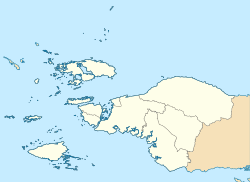| Kalabra | |
|---|---|
| Beraur, Moi Klabra | |
| Native to | Indonesia |
| Region | Beraur District, Sorong Regency, Southwest Papua |
| Ethnicity | Moi Klabra |
Native speakers | (3,300 cited 2000) [1] |
West Papuan?
| |
| Language codes | |
| ISO 639-3 | kzz |
| Glottolog | kala1256 |
| Coordinates: 1°26′S131°37′E / 1.43°S 131.62°E | |
Kalabra (Beraur) is a Papuan language of the Moi Klabra tribe in Bird's Head Peninsula of New Guinea. It is closest to Tehit. Kalabra is spoken in Beraur District, Sorong Regency, Southwest Papua.


